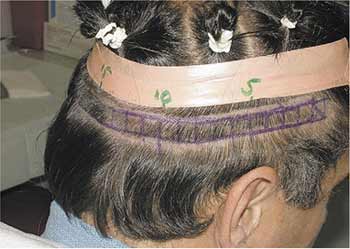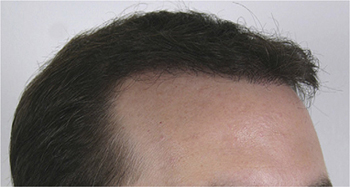Hair Transplantation
An individual's hair plays an important role in his or her overall appearance. Framing the face, hair helps to draw the observer to the focus of the face: the eyes. Hair also conveys nonverbal clues about an individual's age and personality. Long, luxuriant hair is associated with youthfulness and physical attrac¬tiveness. Balding, thinning, and graying hair signifies maturity and advanced age.
As a result, hair restoration has long been considered an integral part of facial rejuvenation. Scalp hair loss—alopecia—can dramatically affect an individual. In fact, alopecia has been associated with signifi¬cant changes in self-image, psychological well-being, and even success in a career. Hair loss draws attention to the forehead, the scalp, and the shape of the head and distracts the viewer from the central face and eyes. Hair loss can be a source of tremendous patient concern and anxiety. Subsequently, individuals invest considerable time and money in seeking treatment. Although alopecia is the result of several different processes, the most common cause remains androgenetic alopecia (AGA). In men, AGA is characterized by the classic hereditary male-pattern baldness. In women, it manifests as a diffuse thinning with an intact anterior hairline, although occasionally a male-pattern type of hair loss can occur.
Aging and hair loss are dynamic processes. Therefore the goal of treatment should be to create and maintain an appearance that remains natural over time. In recent years there has been an explosive growth in techniques for the management of alopecia. New advances in both medical and surgical treatments have been developed and modified to achieve more natural appearing and undetectable hair restoration. Current medical therapies provide powerful treatment options that arrest hair loss and, in some patients, provide hair regrowth. Advanced surgical techniques such as follicular-unit hair transplantation have replaced the traditional procedures such as plug grafts, scalp reductions, and rotational flaps to become the state of the art in terms of incon¬spicuous hair restoration
The average scalp has approximately 100,000 to 150,000 hairs. Hair density must decrease by 50% before alopecia becomes noticeable The formation of hair is a cyclical but asynchronous process that has periods of growth, involution, rest, and shedding. The majority of hair follicles in the scalp (approximately 90%) are in the growth, or anagen phase. This growth phase lasts approximately 3 to 10 years and is longer in women than in men. In the next stage, the catagen phase, proliferation ceases and involution occurs. Less than 1% of the hair follicles are in the catagen phase, which lasts for less than 2 weeks. The remaining 5% to 13% of hair follicles are in the resting, or telogen phase. This stage last approximately 3 to 4 months during which there is no active hair growth. Alternatively, proteolytic enzymes may be induced during the telogen phase, which causes the hair shaft to be shed during exogen phase. Fifty to 100 hairs may enter the exogen phase each day from the normal telogen phase, and up to 400 may shed during a telogen effluvium . The cycle begins again with the anagen phase and results in new hair growth from the area of shedding or displaces the previous hair shaft. Androgens play an essential role in regulating hair growth. At puberty, androgens increase the size of the follicles in the beard, chest, and extremities while decreasing the size of the follicles in the temporal region, thereby reshaping the anterior hairline.
Medical Management Before considering a surgical approach to a patient's alopecia, any treat¬able etiologic factors should be eliminated. Endocrinopathies associated with hair loss should be appropriately managed. Scalp infections need to be properly diagnosed and treated. Numerous topical and oral treatments for androgenetic hair loss claim hair regrowth. Only two therapies, topical minoxidil and oral finasteride , have been clinically proven to be effec¬tive for preventing further hair loss and promoting future growth. Both drugs affect the hair growth cycle via different mechanisms of action and result in an increase in existing hairs' length and diameter. Because hair loss is a progressive disease, medical treatment is required even for the individual who is contemplating hair restoration surgery. These medications slow the progression of hair loss. Their major limitation, other thanongoing cost, is that once they are stopped, the patient's hair loss will revert to the starting pattern,that is, everything he gained during the period he was on the medications is lost.
Surgical Management Surgical options for alopecia have ranged from individual follicular-unit hair graft transplantation to scalp reductions and axial flap transfers. The goals of surgery are to create a natural-appearing hairline, increase scalp coverage, and to camouflage scars if present. In addition, the patient must be informed that usually two to four grafting sessions may be required to recreate a substantial anterior hairline and an increase in hair density. Although the patient may be satisfied by the results of a single extensive transplant session, we stress that it is unlikely for hair restoration to be completed with the first operation.
Follicular-Unit Hair Transplantation Hair transplantation with hair grafts (based on the follicular unit) has been modified over the last two decades to become the established method of choice for hair restoration. Earlier grafting techniques depended on harvesting 15- to 20-hair, 4-mm round punch grafts, which evolved into 3- to 6-hair minigrafts, single-hair micrografts, and currently follicular unit grafts. In this technique hair follicles are harvested as a strip from the back of scalp (permanent Zone) and after separation into individual follicles are inserted over areas of baldness using the stick and place technique.
Follicular-Unit Extraction In the past 4 years, there has been an increasing interest in harvesting follicular-unit grafts individually so as not to have a linear scar in the donor site as occurs in standard strip harvesting. The follicular unit is extracted, trying not to damage it or the surround¬ing follicles. Transplanting to the recipient area is directed by a "stick and place" method.
Dr. Jayanthy is trained specialising in this technique and has her certification from the centre in India with affiliation to the Hair Sciences Centre in Colorado, USA. This technique is virtually painless / scarless compared to FUT hair transplantation.














Complications Complications from follicular-unit transplantation are uncommon. Poor results can be due to inappropriate design and technique. A hair¬line placed too low is often done in accordance with a patient's requests; In addition, telogen effluvium (temporary hair loss, "shock loss") may occur in both donor and recipient regions as a result of the surgical manipulation of the adjacent hairs. The patient must be informed of this possibility before undergoing the procedure, and he or she needs to be reassured that hair regrowth is expected in approxi¬mately 3 months, along with the growth of the transplanted hairs. Epidermal cysts and ingrown hairs are the most common complication from 6 to 14 weeks post transplant; these require unroofing with a needle tip. Temporary hypoesthesia is possible, primarily in the regions that are cephalad to the harvested donor strip. Scarring is usually minimal. However, with repeated harvests some donor site scars—primarily in the lateral occipital regions—may widen with time. Graft survival may decrease slightly during subsequent sessions as a result of scarring and altered vascularity at the recipient sites.
Patient Information. Hair Transplant is done as a day surgery and patient is sent home immediately after surgery. Sutures at the back of hair is removed after two weeks. First hair wash is allowed on the 3rd post operative day. Medical treatment to be resumed after the first week of surgery.
Cost for FUT
Half Strip 40 thousand INR
Three forth strip 60 thousand INR
Full strip 90 thousand INR
Cost for FUE 80INR per graft











